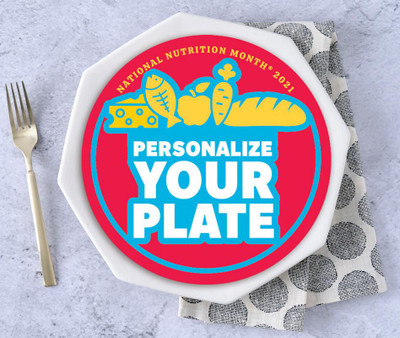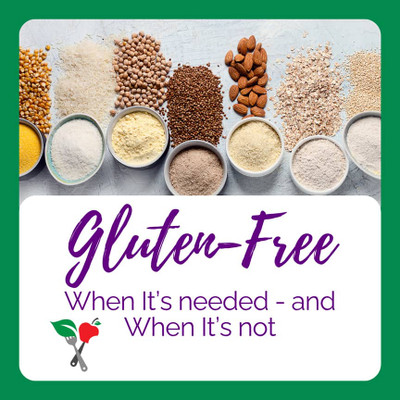Personalize Your Plate for National Nutrition Month
Every March since 1980, we have celebrated National Nutrition Month. This campaign was created by the Academy of Nutrition and Dietetics to help people make informed food choices and develop healthy eating and physical activity habits. The theme of National Nutrition Month for 2021 is “Personalize Your Plate.” The theme acknowledges that we are all unique with different bodies, goals, backgrounds, and tastes and there is no one-size-fits-all approach to nutrition and health.
Research has shown that a healthy dietary pattern can help to reduce the risk of many chronic conditions including heart disease, Type 2 diabetes, overweight and obesity, and some types of cancers. Not everyone’s eating patterns will look that same, and that’s okay! The importance is that we focus on meeting our individual needs, adding nutritious items every day, and strive for balance with our favorite foods. By doing this in a way that works for you, the changes you make will be ones that you can stick to which will offer health benefits that yo-yo dieting and fad diets cannot!
National Nutrition Month is a good time to commit to eating a variety of nutritious foods every day. The first key message is to focus on including healthful foods from all food groups. No matter what your taste preferences and health needs are, including a variety of foods from different food groups helps give your body exactly what it needs.
Hydrating yourself with healthy beverages is another key message for this year’s campaign. Including water, low-fat or non-fat dairy products, unsweetened and fortified milk alternatives, and unsweetened tea and coffee in your regular diet will help curb out empty calories and significantly reduce the amount of added sugars in the diet. Juices should be limited as they do not have the fiber and hunger-fighting effect that whole fruits do, but if you do choose to drink juice, look for 100% fruit juice with no added sugar and stick to a 4 oz. glass.
Reading the Nutrition Facts Panel helps empower you to make informed food choices. Keeping an eye on sodium, saturated fats, and added sugars helps to control your risk for disease and directs you towards more nutrient-packed foods. Always start by looking at the servings per container and serving size, this is the amount that all the numbers on the label reflect. Remember, if the serving size is 1-cup and you eat 2-cups, you will be getting twice the calories, fat, and other nutrients listed on the label. Use the Daily Values (DV) to help you evaluate how a food or beverage fits into your daily eating plan. If you see 5% or less for a certain nutrient, that is considered low and 20% or more is considered high. Try to aim high for vitamins, minerals, and dietary fiber and low for saturated fat, trans fat, sodium, and added sugars.
One of the last key messages for National Nutrition Month is to eat mindfully. Eating while distracted with work, the television, or while driving leads to less enjoyment of your food and may cause you to eat more calories than you realize. Taking time to enjoy your food helps you to appreciate the flavors, slow down your eating speed, and recognize when you start to feel satisfied. With our fast-paced lives, this can be challenging but there are immense benefits from slowing down.
The Academy of Nutrition and Dietetics has put together a list of important questions to ask yourself to determine if an eating plan is right for you. I love this list because it not only outlines important healthy eating principles but also encourages you to think about your personal preferences and needs: Does it include:
- Foods from all of the food groups?
- The right number of servings from each group?
- Foods you will enjoy eating for the rest of your life?
- Foods you easily have access to?
- Some of your favorite foods?
- Foods that fit your budget and lifestyle?
- Regular physical activity or exercise?
If you can answer “yes” to all of these questions, this dietary pattern is likely one that will put you on a path for long-term success and help meet your personal goals. Simple changes can often build upon themselves and turn into big transformations. Start simple and personalize your plate with the following recommendations for making better food choices within each food group.
FRUITS & VEGETABLES
A great place to start is by focusing on your plate at mealtimes. It is recommended to fill half of your plate with a variety of fruits and vegetables. Variety is the spice of life and this is very important to keep in mind when you focusing on improving your eating habits. Different colored fruits and vegetables provide different vitamins, minerals, antioxidants, and dietary fiber. By including an assortment of produce, you will improve your overall nutrition.
For most people, it is recommended to eating 1 ½ to 2 cups of fruit and 2 to 3 cups of vegetables per day. Many people fall short of the recommended servings and lack variety when it comes to fruits and vegetables. Personalizing your plate to include more fruits and vegetables will help you improve your intake of nutrients that many people do not get enough of, including dietary fiber, potassium, folate, magnesium, and vitamins A, C, and K. Research has shown that eating enough fruits and vegetables is associated with lower rates of many chronic diseases.
Are you not meeting the recommended servings of fruits and vegetables each day? Some suggestions to increase your intake include:
- Enjoy fruit or vegetables as a healthy snack, just grab-and-go!
- Try substituting fruit in place of other desserts to satisfy your sweet tooth
- Add fruit to smoothies, sauces, salads, and oatmeal
- Use sliced fruit for your sandwich or toast instead of jelly
- Toss chopped veggies into eggs or grits at breakfast
- Have raw vegetable slices available to add to a salad or dip into hummus for a snack
- Add raw or cooked vegetables, such as cucumber, tomato, or sautéed onions and peppers, to sandwiches, tacos, and wraps
GRAINS
When visualizing your plate, it is recommended that one-quarter of your plate should consist of grains. This includes rice, cereals, pasta, and bread. Whole grains provide dietary fiber, a variety of antioxidants, vitamins, and minerals. It is recommended to make half your grains whole-grain. Many people consume enough grain products every day, however, they do not meet the goals for whole grains.
It is important to substitute whole grains for refined grains as much as possible. Whole grains may help reduce the risk of heart disease and may be linked to healthier body weight. Some evidence suggests that switching from a diet high in refined grains to including more whole grains may lower the risk for type 2 diabetes.
Increase your intake of whole grains by trying some of these tips:
- Choose whole-grain bread for sandwiches and toast
- Use brown rice or whole-grain wild rice in place of white rice
- Substitute whole-grain pasta and whole-grain corn or whole-wheat tortillas
- Check the ingredient list for the words “whole grain” before the grain’s ingredient name
- Experiment with new grains: millet, quinoa, amaranth, bulgur, farro, and teff are other whole grains you may be unfamiliar with that offer many health benefits
PROTEIN
The last quarter of your plate should be filled with protein foods including chicken, fish, beans, peas, lentils, nuts and seeds, eggs, and lean meats. Protein foods provide B vitamins, vitamin E, iron, zinc, and magnesium. Many people consume enough protein daily to meet their individual needs. Shifting protein choices to include more beans, fish, and other lean protein foods will help to reduce your total and saturated fats.
A variety of protein foods including plant-based proteins and seafood is recommended. Animal-based food—meat, poultry, fish, and eggs— and soybeans deliver high-quality protein and all essential amino acids. Fish, nuts, and seeds provide more unsaturated (healthy) fats than meat does. Plant-based proteins also provide dietary fiber. The American Heart Association and the Mediterranean Diet recommends including seafood twice a week to increase your intake of omega-3 fatty acids which may help reduce the risk for heart disease. Processed meat and red meat should be limited if consumed at all, as they are high in saturated fats, sodium, and have been linked to an increased risk for heart disease and certain cancers.
Make healthy choices by following these suggestions:
- Focus on lean or low-fat proteins, to be considered lean it must be at least 92% lean
- Prepare proteins in healthful ways such as grilled, baked, broiled, or roasted instead of fried
- Choose skinless poultry or remove the skin from poultry prior to cooking
- While preparing meat, cut off any visible solid fat, drain the fat after cooking ground meat, and skim off any hardened fat after chilling juices before adding to stews, soups, and gravies to lower the total and saturated fat
- Several times a week plan meals around plant-based proteins such as beans, peas, or soy foods
- Enjoy eggs any time of the day
DAIRY
The final food group is dairy, which is recommended to be added to complete your meal. Dairy foods include milk, yogurt, and cheese. Swapping out a glass of skim or low-fat milk for a sugar-sweetened beverage, like soda or lemonade, will remove unnecessary added sugars and empty calories and add in protein, potassium, calcium, and vitamin D. Many people are not meeting the recommended amounts of these nutrients in their daily diets. Achieving adequate amounts of calcium and vitamin D is difficult without a regular intake of dairy foods.
Including dairy regularly has been linked with improved bone health, especially for children and adolescents. And regularly consuming dairy throughout one’s life reduces the risk of low bone mass and osteoporosis. The calcium and potassium in milk and yogurt help maintain healthy blood pressure as well.
Calcium-fortified soy milk is included in the dairy group for people who cannot drink milk or choose not to. Lactose-free milk is another great option for individuals with lactose intolerance. Both fortified soy milk and lactose-free milk provide similar nutrients as regular milk.
Make the most of your dairy by following this advice:
- Replace whole and full-fat dairy products with low-fat and fat-free versions
- Try including a glass of milk with your meals
- Use low-fat yogurt for a parfait
- Choose low-fat or skim milk as additions to cream-based soups and oatmeal
- Forget high-fat creamers, use skim milk or calcium-fortified plant-based milk in your coffee drinks or smoothies
- Replace sour cream with low-fat Greek yogurt in dips
- If you’re lactose intolerant don’t cut out all dairy: Try smaller amounts at a time or try yogurt which is low in lactose
By adding in nutritious items from all of the food groups and limited saturated fats, salt, and added sugars you will provide your body with all of the nutrients it needs for overall good health. By focusing on your plate, you will benefit from better portion control, a more filling plate, and naturally limit foods that offer little nutrition. Remember, everyone is different so it’s okay if your healthy eating plan does not look like your coworker’s, family member’s, or your best friend’s. A healthful eating style can and should be as unique as you!
At Seattle Sutton’s Healthy Eating we are excited to promote National Nutrition Month and the message of personalizing your plate! While everyone’s needs and preferences may be different, the message to keep things simple and emphasize nutritious foods is one we couldn’t agree with more. With our convenient meals planned by dietitians to provide exactly what your body needs, we are sure you will find a meal plan that will meet your individual needs to set you on the path to feeling your best. We feature a variety of flavors, cultural foods, and traditional favorites to please all of your taste buds while keeping it simple and never boring! Happy National Nutrition Month!
Interested in eating healthy? Hungry for more?








 Weight Loss
Weight Loss Health & Wellness
Health & Wellness Diabetes
Diabetes Heart Health
Heart Health Motherhood & Family
Motherhood & Family Dietary Restriction
Dietary Restriction Other Health Conditions
Other Health Conditions About SSHE
About SSHE


